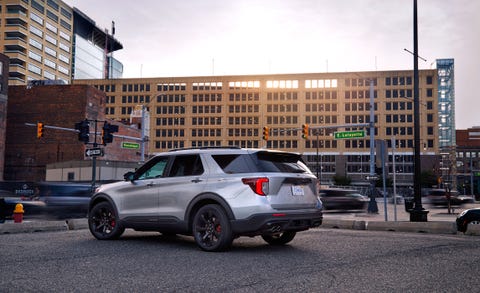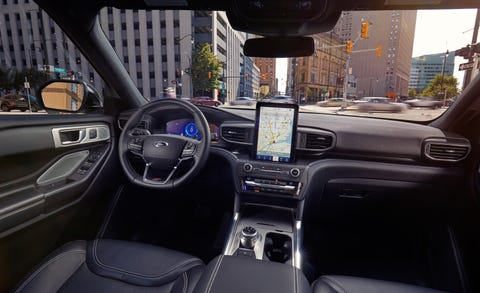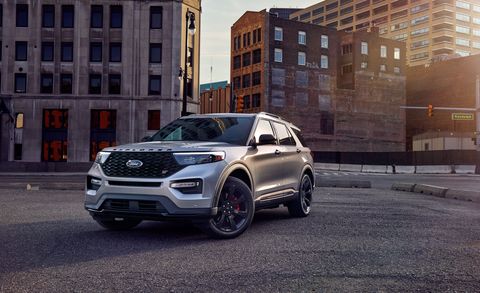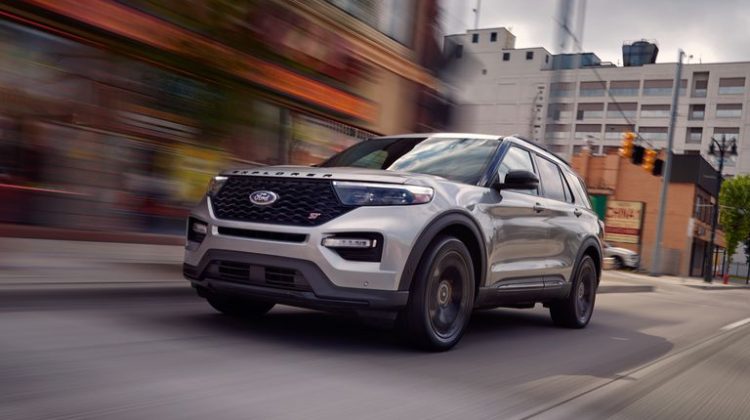The 400-HP Ford Explorer ST Is Quick, Compelling, and Unexpected
Ford moves its new Explorer to a rear-drive platform, then hot-rods it with a potent V-6 and all-wheel drive.
The 2020 Ford Explorer ST pictured here can get to 60 mph in a scant 5.2 seconds, which is only a tenth of a second quicker than a 1991 GMC Typhoon could. How many of us would have thought back at the dawn of the grunge decade that the utterly outrageous GMC would be a harbinger of the future? We’d guess zero. At the time, the Typhoon and its pickup brother, the Syclone, were bizarre, out-of-the-blue-sky anomalies. But look around now: The market is chockablock with high-powered, hunkered-down SUVs. The Explorer ST, like the Typhoon, is powered by a turbocharged V-6. Both are all-wheel drive. And both eschew chrome and brightness in a bid to look at least a little bit menacing. A note to Ford’s communications staffers, who are no doubt less than thrilled about us equating their new hotness with a nearly 30-year-old GM product: Don’t worry; this part will be over soon.
The Explorer ST is not actually like the GMC Typhoon. For one thing, the Ford isn’t named after a storm capable of creating widespread calamity and death. It doesn’t even get its own name, just its own suffix: ST. And before we go all independent-music-store snobby about applying that suffix to this three-row SUV, let us remember that the sum total of the history of ST in the U.S. before Ford started slapping it on SUVs was only two cars: the Focus ST, which was an admirable effort, and the Fiesta ST, which, living up to its name, was a party on wheels, a splash in the waves, as precious as Tuesday afternoon drunkenness.

Also, compared with the Typhoon, the Explorer ST has twice as many doors, two more seats, two fewer drum brakes, six more forward gears, one fewer live axle, and wheels that are five inches greater in diameter. By our measurement, it will travel seven more miles for each gallon of fuel consumed. And the cheeky Explorer ST will give you a butt massage (front-seat passengers only).
This silver ST is the first new Explorer that we’ve had the chance to take to the test track. But all 2020 Explorers benefit from an entirely new platform, which manages the nice trick of growing only an inch longer while riding on a wheelbase that expands by more than six inches. Just as impressive is that our well-equipped ST’s curb weight was 127 pounds lighter than a 2017 Explorer Platinums. It’s still a plump 4853 pounds, but we’re trying to be encouraging here. And that weight is better distributed between the front and rear than the last Explorer’s was; the new one carries only 51.3 percent of its heft on its front axle, compared with 54.9 in the last generation. That’s in part because this Explorer has its engine mounted longitudinally instead of transversely. Also, the base model is now rear-wheel drive instead of front-drive. All STs are all-wheel drive.

The new Explorer’s short overhangs, taut musculature, and plunging roofline give it a look that is both sportier and more elegant than the outgoing model’s. Black 21-inch wheels contribute to the appearance of our ST. They’re part of the $995 ST Street package that also includes red-painted sliding brake calipers, front and rear; larger brake rotors; and high-temp seals in the braking system. Opt instead for the $1595 High Performance pack and you get the same upgrades plus more aggressive brake pads. And to really drive home the sportiness of the thing, Ford added a set of $2500 Michelin Latitude Sport 3 summer tires. All other Explorers come with all-seasons.
Compared with the Platinum, the ST rides on stiffer springs (10 percent more so in front and 8 percent in the rear), retuned dampers, and fatter anti-roll bars. Ford also tweaked the electric-assist steering system to deliver a weightier feel. And the twin-turbocharged 3.0-liter V-6, effectively the same engine used in certain Lincoln models, delivers 400 horsepower and 415 pound-feet of torque. The Platinum uses a 365-hp version of this engine, while XLT Explorers make do with a 300-hp turbocharged 2.3-liter inline-four. Limited models use either the four-cylinder or a 318-hp hybrid based on a 3.3-liter V-6.

The ST’s engine might be a half-liter smaller than the old Explorer’s optional twin-turbo 3.5-liter V-6, but it makes 35 more horsepower and 65 more pound-feet of torque. Predictably then, the new vehicle is quicker. And more important, it feels substantially quicker on the road. Once the 10-speed automatic decides on the optimal gear, this rig moves out with surprising authority. That transmission, the only one available on any new Explorer, does occasionally dither, swapping gears multiple times when a single change would suffice. We find that switching the drive mode to Sport helps alleviate some of the transmission’s indecisiveness and sharpens throttle response to just this side of touchy. Our only other powertrain quibble is that the engine note is less of a mechanical symphony than a moan. And Sport mode merely amplifies that noise.
The stiffer suspension and summer tires deliver at the test track. The ST pulls to a stop from 70 mph in 161 feet. Most three-row SUVs take at least an additional 10 feet to get that done. And the ST circled our 300-foot skidpad with 0.86 g of lateral grip. That is, of course, more than non-sportified, all-season-tire-wearing three-row SUVs can manage—they tend to return figures in the low to mid-0.80s—but we expected more out of a vehicle with big summer tires mounted to a relatively stiff suspension.
On the road, the ST’s ride is not objectionable, but there’s no denying that the vehicle’s sporting intentions and big wheels give it a heavy-footed feeling. Despite the grip of the tires, the starch in the suspension, and a structure that feels rock solid, the Explorer ST is not as coordinated as we’d hoped it would be, either. The brakes on our test car were grabby, and it took more effort on our part to achieve smooth, consistent stops than it should have taken. The steering action is heavy through the thick-rimmed wheel, but it feels artificially so. There’s none of the buildup of forces that, in the best sporting machines, telegraph the status of grip to the driver. Combine that with a transmission that likes to let the engine rest at every opportunity, requiring multiple downshifts and turbo spool-up to get into the thrust, and the Explorer ST is not a natural performance vehicle. Rather, it’s a normal vehicle with extra grip and a lot of horsepower.

There’s still much to like about the overall redo of this normal vehicle. The interior of the previous Explorer was a dismal affair. Its high beltline made us feel as though we were sitting in a giant soaker tub constructed of cheap black plastic panels. The new interior, though still a composition entirely in black in this example, is a pleasant place to spend some time. The apparent quality of the materials is at least on par with the best in the Explorer’s mainstream competitors. There are only a few pieces of questionable refinement, such as the panel on the center stack surrounding the climate-control knobs. It’s hard, hollow, and ungrained, making it feel and look cheap. Such a piece wouldn’t be off-putting in an XLT, which starts at less than $40,000. But it’s a little harder to swallow on our test vehicle, which carried an MSRP of $62,020.
At least the ST comes well equipped for its $55,835 base price, including niceties such as automated parking, a wireless charging pad, a navigation system, automatic high-beam headlights, rain-sensing wipers, heating for the steering wheel and the front- and second-row seats, ventilation for the front seats, remote start, a Wi-Fi hotspot, and leather upholstery. Front-seat massage, a 10.1-inch center screen, and a 14-speaker audio system added $995. That portrait-oriented infotainment screen is useful, even if, standing proud of the dash, it looks conspicuously like the mysterious black monoliths from 2001: A Space Odyssey. For another $1695, our test vehicle came with a dual-pane sunroof. That’s nice for brightening the interior, but it eats up more than two inches of precious headroom for second-row passengers, making it barely tolerable for adults to sit there. In fact, with the sunroof, headroom in the third row is slightly better than in the second, which is great except that Ford achieved this in part by slamming the bottom cushion down on the floor, putting passengers in a knees-up posture that they will resent. Cargo space is ample, roughly halfway between the capacity of a Mazda CX-9 on the small end and that of a Chevrolet Traverse on the big.
Perhaps the Platinum model, with most of the ST’s power and none of its overt sporting intentions, would be more to our liking. Maybe we’ve gotten soft in the three decades since the launch of the Typhoon, but we appreciate the basic Explorer package more than we do the integration of its performance upgrades.
Counterpoints
I relish any opportunity to shake my fist at the SUV takeover, and the Explorer ST—as impressive as it is—is an easy target. The extra weight and height that come with a package like this are the enemies of performance, ostensibly the ST’s primary mission. So if Ford’s engineers were able to make this tall, nearly 5000-pound family bus corner this well and accelerate this quickly, then imagine what they could have done with this platform and powertrain if they had fitted a lower, lighter sedan body on top of it and called it the Taurus SHO. Sure, the Chevy SS was a flop, but the Dodge Charger could really use a good crosstown rival. It’s an alternate universe I wish I lived in. —Joey Capparella, staff editor
All expensive Fords—Lincolns included—have the same problem: They simply cost too much. They’re priced as if they were all-around more-premium products than they are. Just look inside this thing. The hard, oddly grained plastic that lines most of the lower half of the interior not only looks as if it had been pulled straight from the old Explorer, it also resembles a popcorn ceiling and is about as appealing as asbestos. And I know what you’ll say: “But this one is based on a rear-drive platform!” Sure, but turn-in is a little doughy, and the front and rear axles roll at different rates. And why does the front end look as though someone punched it flat? Durango SRT, please.
Source caranddriver.com


